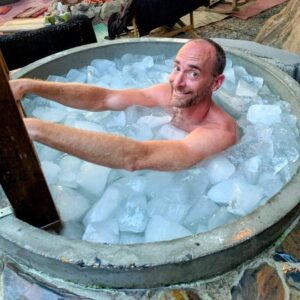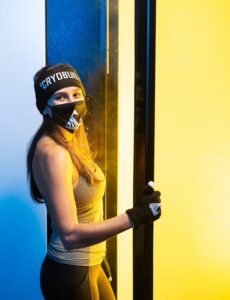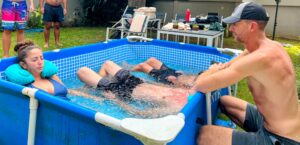Intro: Embracing the Chill
In the world of wellness and recovery, two icy contenders have been making waves: cryotherapy and ice baths. But what exactly are these cold therapy techniques, and how do they differ? Whether you’re an athlete looking to boost performance or someone seeking natural ways to enhance well-being, understanding the nuances of cryotherapy vs ice bath can help you make an informed decision about which method might be right for you.
A Brief History of Cold Therapy
Cold therapy isn’t a new concept. In fact, it’s been used for centuries:
- Ancient Egyptians applied cold compresses to treat injuries and inflammation
- Hippocrates recommended snow and ice to reduce swelling
- In the 1800s, Napoleon’s surgeon general observed that soldiers who warmed by the fire died more often than those left in the cold
Today, we’ve refined these practices into more controlled methods like cryotherapy chambers and precisely measured ice baths. But the core principle remains the same: harnessing the power of cold for health benefits.
The resurgence of interest in cold therapy has been partly fueled by influential figures like Wim Hof, also known as “The Iceman”. Hof has popularized cold exposure techniques and breathwork, claiming numerous health benefits [1].
Personal Touch: My Cold Therapy Journey

As someone who’s experienced both cryotherapy and ice baths firsthand, I can attest to their invigorating effects. From my time working at Bulletproof Upgrade Labs in Santa Monica to guiding ice bath sessions in Chiang Mai, I’ve explored the spectrum of cold exposure. Each method offers unique sensations and benefits, which we’ll dive into throughout this article.
Understanding Cryotherapy: The Big Chill
What is Cryotherapy?
Cryotherapy, literally meaning “cold therapy,” is a technique that exposes the body to extremely cold temperatures for a short period. While it can be applied locally, whole-body cryotherapy (WBC) has gained popularity in recent years.
How Cryotherapy Works
- You enter a cryotherapy chamber or booth
- Your body is exposed to ultra-low temperatures (typically -110°C to -140°C or -166°F to -220°F)
- The extreme cold triggers a physiological response
- Blood vessels constrict, reducing blood flow to the extremities
- After exiting, blood rushes back to the periphery, potentially bringing various health benefits
A 2020 systematic review published in the International Journal of Environmental Research and Public Health found that whole-body cryotherapy can be effective in reducing muscle pain and improving recovery in athletes [2].
Types of Cryotherapy
- Whole Body Cryotherapy (WBC): Involves standing in a chamber that envelops the entire body, except for the head

- Localized Cryotherapy: Targets specific areas of the body using cold air or ice packs
Typical Session: Quick and Cold
Based on my experience at Bulletproof Upgrade Labs:
- Duration: Usually around 3 minutes
- Temperature: Extremely cold (exact temperature may vary by facility)
- Clothing: Minimal, with protection for extremities (gloves, socks, shoes)
Required Equipment and Facilities
Cryotherapy typically requires specialized equipment:
- Cryotherapy chamber or booth
- Liquid nitrogen or electrically cooled air system
- Trained operator to monitor the session
- Safety gear for participants
This need for specialized equipment often means cryotherapy is available only at dedicated facilities or high-end gyms.
Diving into Ice Baths: The Classic Cold Plunge
What is an Ice Bath?
An ice bath, also known as cold water immersion, involves submerging the body in cold water for a set period. It’s a more accessible form of cold therapy that can be done at home or in many gym settings.
How Ice Baths Work
- You immerse your body in cold water (typically up to neck level)
- The cold water causes blood vessels to constrict
- This reduces blood flow to the immersed areas
- After exiting, increased blood flow may aid in recovery and provide other benefits

Dr. Rhonda Patrick, a biomedical scientist and expert on nutritional health, has discussed the potential benefits of cold exposure, including improved mood and cognitive function [3].
Unique Effects of Water Immersion
Ice baths offer some distinct advantages over cryotherapy due to the properties of water immersion:
- Hydrostatic Pressure
- Water exerts pressure on the body, increasing with depth
- Benefits of hydrostatic pressure:
- Improved circulation
- Reduced swelling
- Enhanced lymphatic drainage
- This pressure effect is absent in cryotherapy
- Mammalian Dive Reflex
- A set of physiological responses triggered by face immersion in cold water
- Key effects:
- Slowed heart rate
- Peripheral vasoconstriction
- Blood shift to vital organs
- Potential benefits:
- Improved cardiovascular efficiency
- Enhanced recovery
- Possible stress-reduction effects
- Full-Body Sensory Experience
- Water provides a more encompassing sensory experience than air
- May enhance mindfulness and presence during the practice
These unique aspects of water immersion contribute to the effectiveness of ice baths and explain why some individuals, including myself, find them particularly beneficial for recovery and overall well-being.
Temperature Ranges and Duration
Based on my experience guiding ice bath sessions in Chiang Mai:
- Temperature: Can range from 2°C to 20°C (35.6°F to 68°F)
- Duration: Typically 1-15 minutes, based on water temperature and individual tolerance
- Interesting note: Even at 20°C (68°F), prolonged exposure (30+ minutes) can induce shivering and cold stress responses
Setting Up an Ice Bath
At home:
- Large tub or container
- Lots of ice
- Thermometer to monitor water temperature
At the gym:
- Dedicated cold plunge tubs
- Temperature-controlled systems for consistent cold
Personal Anecdote: The Face-in-Cold-Water Bowl Technique
When I lived in LA, I developed a unique cold exposure method:
- Keep a bowl of water in the refrigerator
- Take it outside to the garden
- Submerge face in the cold water while holding breath for 1-3 minutes
- Result: An incredibly energizing experience!
This simple technique demonstrates that even brief, localized cold exposure can have invigorating effects.
In the next sections, we’ll delve deeper into the key differences between cryotherapy and ice baths, explore the science behind cold therapy, and discuss the myriad benefits these chilling practices can offer. Stay tuned!
Cryotherapy vs Ice Bath: Key Differences
While both cryotherapy and ice baths fall under the umbrella of cold therapy, they differ in several key aspects:
1. Temperature Exposure
- Cryotherapy: Extreme cold (-110°C to -140°C / -166°F to -220°F)
- Ice Bath: Cold, but less extreme (2°C to 15°C / 35.6°F to 59°F)
2. Duration of Treatment
- Cryotherapy: Very short (typically 2-3 minutes)
- Ice Bath: Longer (usually 1-15 minutes, sometimes up to 20 minutes)
3. Body Coverage
- Cryotherapy: Whole body except head (in whole-body cryotherapy)
- Ice Bath: Usually up to neck level, but can vary
4. Dry Cold vs. Wet Cold
- Cryotherapy: Dry cold air
- Ice Bath: Wet cold water (which can feel more intense due to water’s higher heat conductivity)
5. Accessibility and Cost
- Cryotherapy: Requires specialized equipment, typically available at dedicated facilities
- Ice Bath: More accessible, can be done at home or in many gyms
6. Control over Temperature and Duration
- Cryotherapy: Controlled by the machine and operator
- Ice Bath: More user control, allowing for gradual adaptation
7. Hydrostatic Pressure and Dive Reflex
- Ice Bath: Provides hydrostatic pressure and can trigger the mammalian dive reflex
- Cryotherapy: Lacks these water-specific effects
The Science Behind Cold Therapy
Cold therapy, whether through cryotherapy or ice baths, triggers several physiological responses in the body:
1. Vasoconstriction and Vasodilation
- Cold exposure causes blood vessels to constrict (vasoconstriction)
- Upon rewarming, blood vessels dilate (vasodilation)
- This process may improve circulation and reduce inflammation
2. Reduction in Inflammation
- Cold therapy can decrease the production of inflammatory mediators
- This may lead to reduced swelling and pain in muscles and joints
3. Hormonal Responses
- Increased production of norepinephrine (boosts alertness and focus)
- Potential increase in production of brown adipose tissue (brown fat)
A study published in the journal PLOS One found that cold exposure can increase the production of brown adipose tissue, potentially aiding in metabolic health [4].
4. Metabolic Effects
- Short-term increase in metabolic rate
- Activation of brown fat, which burns calories to generate heat
5. Nervous System Stimulation
- Cold exposure activates the sympathetic nervous system
- This can lead to increased alertness and energy
Benefits of Cold Therapy
Both cryotherapy and ice baths offer a range of potential benefits:
- Enhanced Recovery After Exercise
- Reduced muscle soreness
- Faster recovery times
- Reduced Inflammation
- May help with chronic inflammatory conditions
- Potential pain relief for arthritis and other joint issues
- Improved Mood and Mental Clarity
- Increased production of endorphins and norepinephrine
- Many users report feeling more alert and focused
Anecdotal evidence from cold therapy enthusiasts, including Silicon Valley executives and professional athletes, suggests improved focus and productivity after regular cold exposure sessions [5].
- Increased Energy and Motivation
- Personal experience: “I always feel amazing after cold exposure – with more energy, better mood, and motivation.”
- Potential Weight Loss and Metabolic Benefits
- Activation of brown fat
- Slight increase in calorie burn
- Improved Sleep Quality
- Some users report better sleep after regular cold therapy
- Increased Resilience and Stress Tolerance
- Regular exposure to cold stress may improve overall stress resilience
- Improved Circulation and Lymphatic Drainage
- Especially prominent in ice baths due to hydrostatic pressure
- May help reduce swelling and promote faster recovery
- Potential Cardiovascular Benefits
- The mammalian dive reflex in ice baths may contribute to improved heart rate variability and cardiovascular health
Personal Experiences and Insights
Having experienced both cryotherapy and ice baths extensively, I can offer some personal insights:
Cryotherapy at Bulletproof Upgrade Labs
- Quick and intense experience
- Felt invigorating and energizing
- Easier to tolerate than other forms of cold therapy due to the dry cold and short duration
Ice Bath Sessions in Chiang Mai
- More challenging but highly rewarding
- Allows for gradual adaptation to cold
- Great for building mental resilience
Comparative Sensations
- Cryotherapy: Intense but brief discomfort
- Ice Bath: More prolonged challenge, especially with full body submersion
Energy Boost and Workout Performance
- Both methods provide a significant energy boost
- Often feel motivated to work out after a cold therapy session
- Enhanced focus and performance during post-cold exposure workouts
How to Get Started with Cold Therapy
If you’re intrigued by the benefits of cold therapy, here’s how to begin:
- Start with Cold Showers
- Begin with 15-30 seconds of cold water at the end of your shower
- Gradually increase duration as you become more comfortable
- Progress to Ice Baths
- Start with water around 15°C (59°F) for 2-3 minutes
- Gradually lower temperature and increase duration
- Try Cryotherapy
- Book a session at a reputable facility
- Follow all safety guidelines provided by the operator
- Attend a Workshop
- For a comprehensive understanding and guided experience, consider attending one of our cold therapy workshops in Chiang Mai [link to workshops]
Remember, consistency is key. Aim for 2-3 sessions per week to experience the full benefits of cold therapy.
Common Concerns and Misconceptions
As cold therapy gains popularity, it’s natural for questions and concerns to arise. Let’s address some of the most common ones:
1. Is cold therapy dangerous?
- When done correctly, cold therapy is generally safe for most people
- However, individuals with certain health conditions (e.g., heart problems, Raynaud’s syndrome) should consult a doctor first
2. Will I get sick from cold exposure?
- Contrary to popular belief, cold exposure doesn’t cause colds or flu
- Some studies suggest it might even boost immune function
3. Is cold therapy only for athletes?
- While athletes often use cold therapy, its benefits extend to non-athletes too
- Anyone looking to improve recovery, reduce inflammation, or boost energy can benefit
4. Isn’t it too uncomfortable?
- Initial discomfort is normal but usually subsides with regular practice
- Many find the post-exposure feeling of invigoration worth the temporary discomfort
5. Can I do cold therapy if I’m not in good shape?
- Start slowly and progress gradually
- Listen to your body and don’t push beyond your limits
- Consider attending a guided workshop to learn proper techniques and safety precautions
Choosing Between Cryotherapy and Ice Baths
When deciding between cryotherapy and ice baths, consider the following factors:
- Accessibility: Ice baths are more accessible and can be done at home, while cryotherapy requires specialized equipment.
- Cost: Ice baths are generally more cost-effective, especially if done at home.
- Time: Cryotherapy sessions are shorter, making them convenient for busy schedules.
- Intensity: Cryotherapy offers more extreme cold but for a shorter duration. Ice baths are less extreme but allow for longer exposure.
- Personal Preference: Some people prefer the dry cold of cryotherapy, while others find ice baths more tolerable or enjoyable.
- Specific Goals:
- For quick recovery between workouts, cryotherapy might be preferable
- For gradual cold adaptation or meditation practices, ice baths could be more suitable
Remember, these methods aren’t mutually exclusive. Many people, myself included, incorporate both into their wellness routines.
The Future of Cold Therapy
As research in cold therapy continues to evolve, we’re likely to see some exciting developments:
- Personalized Protocols: Advanced biometric tracking may allow for more tailored cold therapy sessions based on individual physiology and goals.
- Integration with Other Therapies: We might see cold therapy combined with other modalities like light therapy or breathwork for enhanced benefits.
- Home Cryotherapy Units: As technology advances, more affordable and compact cryotherapy units for home use may become available.
- Virtual Reality Integration: VR could be used to create immersive experiences during cold therapy sessions, potentially making them more enjoyable and effective.
- Expanded Medical Applications: Ongoing research may uncover new therapeutic uses for cold therapy in treating various health conditions.
Recent research published in the North American Journal of Medical Sciences suggests potential applications of cryotherapy in managing symptoms of fibromyalgia and rheumatoid arthritis [6].
Conclusion: Embracing the Cold
Whether you choose cryotherapy, ice baths, or a combination of both, cold therapy offers a powerful tool for enhancing physical and mental well-being. From improved recovery and reduced inflammation to increased energy and resilience, the benefits of controlled cold exposure are numerous and well-documented.
As with any wellness practice, the key is to start slowly, listen to your body, and be consistent. Whether you’re an athlete looking to optimize performance or someone seeking natural ways to boost health and vitality, cold therapy could be a game-changer in your wellness journey.
Ready to take the plunge? Consider joining one of our cold therapy workshops in Chiang Mai [link to workshops] for a guided introduction to this invigorating practice. Remember, the journey of a thousand miles begins with a single step – or in this case, a single shiver!
FAQs
Q1: How long should I stay in an ice bath?
A: For beginners, start with 2-3 minutes in water around 10-15°C (50-59°F). Gradually increase to 10-15 minutes as you build tolerance.
Q2: Can I do cold therapy every day?
A: While some people practice daily, 2-3 times per week is generally sufficient to experience benefits. Listen to your body and adjust accordingly.
Q3: How cold should the water be for an effective ice bath?
A: Water temperatures between 10-15°C (50-59°F) are typical for ice baths. Some advanced practitioners go as low as 4°C (39°F).
Q4: Is cryotherapy better than ice baths for muscle recovery?
A: Both can be effective. Cryotherapy might be more convenient due to its shorter duration, while ice baths allow for longer exposure times.
Q5: Can cold therapy help with weight loss?
A: While not a primary weight loss tool, cold exposure can boost metabolism and activate brown fat, potentially supporting weight management efforts when combined with proper diet and exercise.
Q6: Why might an ice bath be more effective than cryotherapy for some people?
A: Ice baths offer unique benefits due to water immersion, including hydrostatic pressure effects and the triggering of the mammalian dive reflex. These can lead to improved circulation, reduced swelling, and potential cardiovascular benefits not present in cryotherapy.
Remember, while this article provides a comprehensive overview, it’s always best to consult with a healthcare professional before starting any new wellness regimen, especially if you have pre-existing health conditions.
References
- Hof, W. (2020). The Wim Hof Method: Activate Your Full Human Potential. Sounds True. URL: https://www.wimhofmethod.com/
- Lombardi, G., Ziemann, E., & Banfi, G. (2017). Whole-Body Cryotherapy in Athletes: From Therapy to Stimulation. An Updated Review of the Literature. Frontiers in Physiology, 8, 258. URL: https://www.frontiersin.org/articles/10.3389/fphys.2017.00258/full
- Found My Fitness. (2019). Dr. Rhonda Patrick on Cold Shock Proteins and Metabolic Health. YouTube.
- van der Lans, A. A., et al. (2013). Cold acclimation recruits human brown fat and increases nonshivering thermogenesis. Journal of Clinical Investigation, 123(8), 3395-3403. URL: https://www.jci.org/articles/view/68993
- Carney, S. (2021). What Doesn’t Kill Us: How Freezing Water, Extreme Altitude, and Environmental Conditioning Will Renew Our Lost Evolutionary Strength. Rodale Books. URL: https://www.scottcarney.com/what-doesnt-kill-us
- Bettoni, L., et al. (2013). Effects of 15 consecutive cryotherapy sessions on the clinical output of fibromyalgic patients. Clinical Rheumatology, 32(9), 1337-1345. URL: https://link.springer.com/article/10.1007/s10067-013-2280-9
Additional resources:
- Dr. Rhonda Patrick’s website, Found My Fitness URL: https://www.foundmyfitness.com/topics/cold-exposure-therapy
- International Journal of Environmental Research and Public Health – Systematic Review on Whole-Body Cryotherapy URL: https://www.ncbi.nlm.nih.gov/pmc/articles/PMC3956737/
